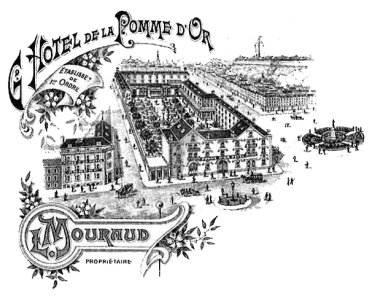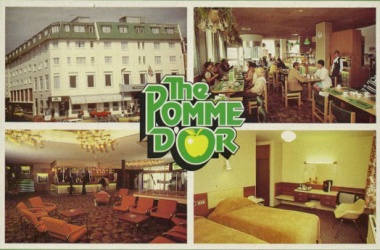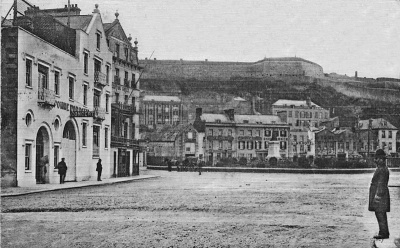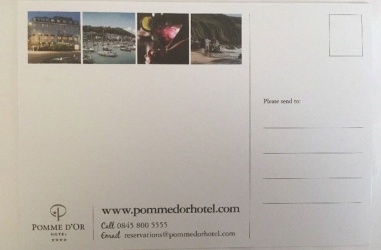From Jerripedia
An artist's impression of the hotel in the first decade of the 20th century, showing the extensive gardens between the Wharf Street and Weighbridge sections of the hotel. The Southampton Hotel to the right has been 'airbrushed' out by the artist. In the bottom left corner of the picture is the Pomme d'Or annexe, which stood on the corner of Conway Street and the Esplanade. The coal store on the opposite corner appears to be an integral part of the hotel, but was not acquired until some 50 years later, after the Second World War
|

The exact date of this picture is not known but it shows the view from the New North Quay towards the Weighbridge and the building which was to become the familiar Victorian waterfront facade of the hotel is a warehouse, owned by Philip Pellier, a corn and flour merchant, between the Southampton Hotel and Le Huquet's coal store, out of view to the left, all built on land reclaimed some 50 years earlier. To the right of the Southampton Hotel can be seen other hotels already in existence, including The Star and the Royal Yacht. Although the Pomme d'Or has not yet spread as far as the waterfront, it had already been in existence at the back of this block since 1837. The picture below shows the same scene from slightly closer. The public weighbridge is just visible on the right and the warehouse has now been redeveloped into part of the Pomme d'Or Hotel, with the Southampton to its right, and the Royal Yacht next on the right, a block further back
A number of hotels lay claim to being Jersey's oldest, and having opened in 1837, the Pomme d'Or hotel has been trading for 175 years, placing it well among the earliest.
Liberation
The hotel's finest hour was on 9 May 1945, when it was the focus for the celebrations of the Liberation of Jersey from the German Occupation. A large crowd gathered outside the hotel to see the Union Flag raised for the first time in five years. The hotel had undergone a major rebuilding in 1937-38, to be completed in time for the Germans to arrive and requisition the hotel for their naval headquarters. The hotel has been refurbished and extended several times since then and now overlooks Liberation Square, which commemorates the end of a darker period.
However, the hotel did not start its life in the prominent waterfront position it has occupied for over a century. It started on the other side of the block on Wharf Street, taking its name from a cider-making business opposite, and a brand name which was as famous in Jersey in the mid-1800s as Mary Ann beer became in the 20th century. The hotel was built by the Pellier family on the site of a private house, previously run as Dale's boarding house.
Philip Ahier's Historical Hotels and Inns of Jersey says that it was situated between two other hostelries, the Navy Hotel and an inn known as The Three Tuns. At this time Wharf Street was a much busier area, having not long been reclaimed from the sea, and the buildings to the seaward side of it were largely warehouses and other stores.
Weighbridge frontage
The Weighbridge frontage of the Pomme d'Or was originally a merchant's store, incorporated into the hotel as it grew in popularity during the second half of the 19th century; extended, and then left derelict for five years in the second half of the 1920s, until it was acquired on 5 February 1930 by Mr and Mrs George Seymour, who were to include it in what would become the island's largest hotel group.
The hotel was mentioned in Auguste Luchet's Souvenir de Jersey written in about 1844. He says that the hotel was under French managament "an establishment replete with good things and noted for its gaiety, where the house, the service, the attention, the wines and the brandies are all French". This theme was to be resurrected when the hotel was rebuilt nearly a century later in 1937 after several changes of ownership.
Political meetings
When the Pomme d'Or was first established, Jersey was going through a period of impassioned party politics, with the Rose and Laurel parties having taken over from the Magots and Charlots, which had been active until the wars with France in the early 19th century. Each party chose a hostelry as its headquarters, and the Laurels met at the Pomme d'Or, with the Rose Party just up the road at the British Hotel in Broad Street
Victor Hugo
No doubt because of the reputation the Pomme d'Or had established in France, Victor Hugo stayed there for a few days when he first arrived in Jersey, before finding accommodation at 2 Marine Terrace.
French advertisement
An advertisement for the hotel appeared in the French newspaper La Reforme on 4 January 1851:
- "Mme Veuve Boisnet a l'Honneur d'informer Messieurs les habitants de cette ile et Messieurs les voyageurs qui frequent les iles Anglaises qu'ils trouveront dans son establishment justement renomme bonne table d'hote a 10 et a 5 heures. Salons particuliers pour les familles et toute les comforts desires. Messieurs les voyageurs de Commerce trouverone tous les renseignements, et de bons magazins pour merchandises. Mme Boisnet a toujours dans cette le Magazin de Commerce trouveront tous Francais et de l'absinthe en gros et en detail." (The widow Mrs Boisnet has the honour to inform the residents of this island and visitors who frequent the English islands that they will find a renowned meal at 10 am and 5 pm. Private rooms for families and all comforts desired. Commercial travellers will find every advice and good shops for their goods. Mrs Boisnet always stocks everything French and absinthe in bulk and for retail.)
Polish exiles in Jersey celebrated the anniversary of the 1830 revilution with a meeting at the Pomme d'Or in November 1861 and the French colony used the hotel for their annual Bastille Day and New Year celebrations for many years. The hotel was under French management in 1900 when demonstrations were held against the French after the Relief of Mafeking. Windows at the hotel were broken.
Various Freemasonry lodges held functions at the hotel and this continued even after the construction of the Masonic Temple in Stopford Road in 1862-63.

An early advertisement of Madame Boisnet's establishment
Expansion
The hotel has expanded considerably over the years, spreading from Wharf Street through to the Weighbridge and Conway Street, but it was not until after the Second World War that the Seymours acquired the Le Huquet coal store on the corner of Conway Street. A German bunker had been built on the site and 2,000 tons of rubble were moved when it was demolished.
Picture gallery
Click on any image to see a larger version

The Wharf Street front of the hotel in 1869, when Mrs Boisnet was in charge
This unique collection of photographs of the Pomme d'Or shows its development from a warehouse in the mid-1900s to a large, modern, 21st century establishment

The board on the left advertises the aquarium at Havre des Pas, and to the right is hairdresser C de la Haye's premises. The smock and hat worn at a jaunty angle by the man in the foreground give no real clue to the age of the photograph.

A couple stand talking in the archway which led through the hotel from the Weighbridge to the courtyard and gardens behind. For many years the gardens, where afternoon teas were served, were an important feature of the hotel

This pictures, enlarged on either side, is from a Victorian glass plate. The exact date is not known, but it was probably as early as the 1850s, the hotel having opened in the mid-1830s. The shape of the building was unchanged for several decades, but this picture shows a low structure to the right with a sign for 'C de la Haye, hairdresser', where the Southampton Hotel was later built. There are many photographs in existence showing an oblique view of the Pomme d'Or and Southampton Hotels side by side, but head-on views of the Pomme d'Or like this are extremely rare.

This photograph is also unusual in that it shows horse-drawn vans queuing with potatoes for export with the Pommd d'Or Hotel in the background. The vast majority of pictures of queues in front of the public weighbridge are taken from the opposite direction. It can be seen that the hotel building has been developed, with a much more balanced and rather attractive facade, although the central archway has been maintained.
The hotel photographed in the 1880s
A bedroom in Victorian times
Staff on the hotel coach, used to meet arriving guests at the harbour
A drawing of the Weighbridge frontage
A view inside the hotel gardens
Entertainment in the hotel gardens
Guests and non-residents could enjoy a drink or a meal in the gardens, and musical entertainment was often provided
A similar view to the previous picture, showing the warehouse now part of the hotel
This view of the Weighbridge entrance to the hotel also clearly shows the 'Pomme d'Or' sign on the building on the opposite corner of Conway Street and the Esplanade
The Weighbridge frontage has now been developed into a more symmetrical shape and the archway which previously opened into the courtyard and garden behind has now been enclosed. Huquet and Sons' coal merchants still occupy the Conway Street corner site

The hotel was derelict in the 1920s, before it was acquired and brought back to life by the Seymour family
A picture taken by Ernest Baudoux in the 1880s
A closer view of the Pomme d'Or on the left, next to the Southampton Hotel
A view of the front of the hotel looking towards Fort Regent
The Weighbridge frontage has yet to be enlarged
An early hotel brochure showing the developed Weighbridge facade and what was originally the main frontage of the hotel in Wharf Street
This view across the Weighbridge gardens in the last decade of the 19th century shows the Pomme d'Or immediately behind the statue of Queen Victoria and the building on the opposite corner of Conway Street, also with a 'Pomme d'Or' sign, then being used as a hotel annexe
The hotel at the height of the potato season. The 'Pomme d'Or' sign has now disappeared from the building on the opposite corner of Conway Street and the Esplanade
Construction work on the new hotel in 1938
Liberation, and everything changes
Crowds outside the hotel on Liberation Day, 9 May 1945
Circa 1950, and the hotel is back in business after the war

The late-19th century Weighbridge frontage
The hotel today, with Liberation Square in front
Fancy dress for the guests in 1938
The new Weighbridge frontage building in 1938
An excursion for hotel guests
Romano's ensemble performed in the garden
The Pomme d'Or and Southampton Hotels
Another view of the terrace in the middle of the hotel block
A ticket for the 1864 dinner to cebrate the opening of the Freemasons' new temple in Stopford Road ...
... and a better quality survivor
A bill for a Freemasons' dinner in 1869. The total price for 52 diners was £9 11s
A programme for hotel entertainment
1964 tourism guide advert
Two Militia horsemen ride past in the late 19th century
German Occupation
German sailors in a bedroom at the hotel during the Occupation
The dining room during the Occupation
German vehicles lined up outside the hotel in 1944
The Germans built a bunker on the corner of Conway Street which was demolished after the war to provide room to expand the hotel
Under German occupation as Naval Headquarters

A 2022 aerial view of the rhomboid-shape hotel in the centre




















































































